ESP Oldsmobile Aurora 1997 Owner's Manuals
[x] Cancel search | Manufacturer: OLDSMOBILE, Model Year: 1997, Model line: Aurora, Model: Oldsmobile Aurora 1997Pages: 404, PDF Size: 20.75 MB
Page 12 of 404
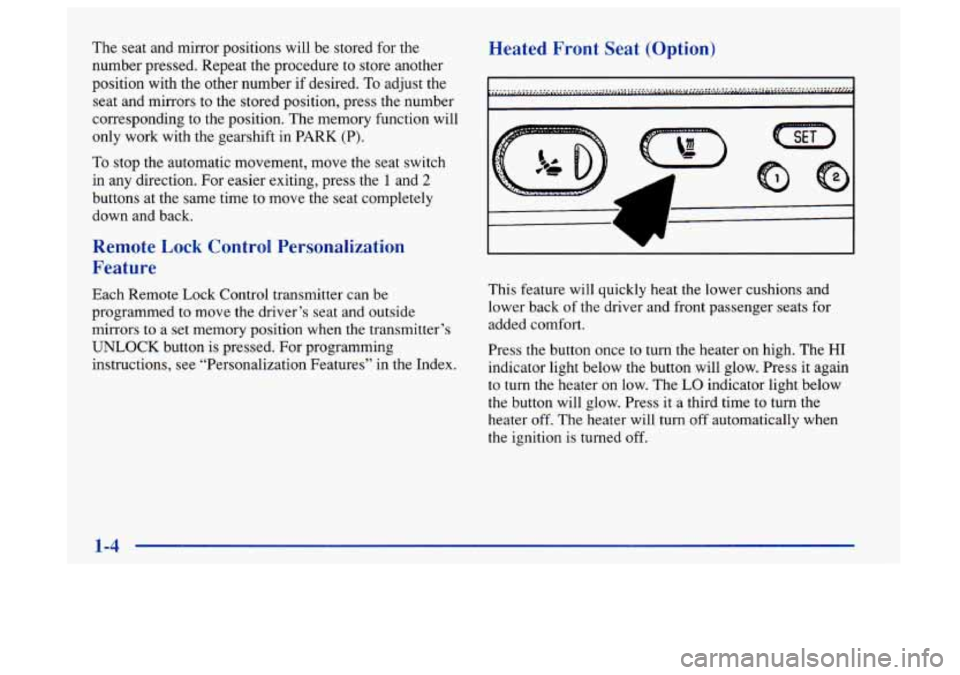
The seat and mirror positions will be stored for the
number pressed. Repeat the procedure to store another
position with the other number if desired.
To adjust the
seat and mirrors to the stored position, press the number
corresponding to the position. The memory function will
only work with the gearshift in PARK (P).
To stop the automatic movement, move the seat switch
in any direction. For easier exiting, press the
1 and 2
buttons at the same time to move the seat completely
down and back.
Remote Lock Control Personalization
Feature
Each Remote Lock Control transmitter can be
programmed to move the driver’s seat and outside
mirrors to a set memory position when
the transmitter’s
UNLOCK button is pressed. For programming
instructions, see “Personalization Features’’ in the Index.
Heated Front Seat (Option)
This feature will quickly heat the lower cushions and
lower back
of the driver and front passenger seats for
added comfort.
Press the button once
to turn the heater on high. The HI
indicator light below the button will glow. Press it again
to turn the heater
on low. The LO indicator light below
the button will glow. Press
it a third time to turn the
heater
off. The heater will turn off automatically when
the ignition is turned off.
1-4
Page 18 of 404

or the safety belts!
With safety belts, you slow down as the vehicle does.
You get more time to stop. You stop over more distance,
and your strongest bones take the
forces. That’s why
safety belts make such good sense.
Here Are Questions Many People Ask
About Safety Belts
-- and the Answers
@ Won’t I be trapped in the vehicle after an
accident
if I’m wearing a safety belt?
A: You could be -- whether you’re wearing a safety
belt or not. But
you can unbuckle a safety belt,
even if you’re upside down. And your chance of
being conscious during and after an accident,
so
you can unbuckle and get out, is much greater if
you are belted.
@ If my vehicle has air bags, why should I have to
wear safety belts?
A: Air bags are in many vehicles today and will be in
most
of them in the future. But they are
supplemental systems only;
so they work with
safety belts -- not instead of them. Every air bag
system ever offered for sale has required the use of
safety belts. Even if you’re
in a vehicle that has air
bags,
you still have to buckle up to get the most
protection. That’s true not only in frontal collisions,
but especially
in side and other collisions.
1-10
Page 60 of 404

1 Door Locks
Unlocked doors can be dangerous. Passengers
== especially children -= can easily
open the doors and fall out. When a door is
locked, the inside handle won’t open it.
Outsiders can easily enter through an unlocked
door when you slow down
or stop your vehicle.
This may not be
so obvious: You increase the
chance
of being thrown out of the vehicle in a
crash if the doors aren’t locked. Wear safety belts
properly, lock your doors, and you will be
far
better off whenever you drive your vehicle.
1 There are several ways to lockand unlock your vehicle.
~ From the outside, use your door key or Remote
Lock Control. From
the inside, to lock the door, rotate the locking
lever forward.
To unlock the door, rotate the locking lever rearward.
There is a red mark
on the switch when the door
is unlocked.
Central Door Unlocking System
If the driver’s door key is held in the unlock position for
more
than one second, all doors will electronically unlock
2-4
Page 66 of 404
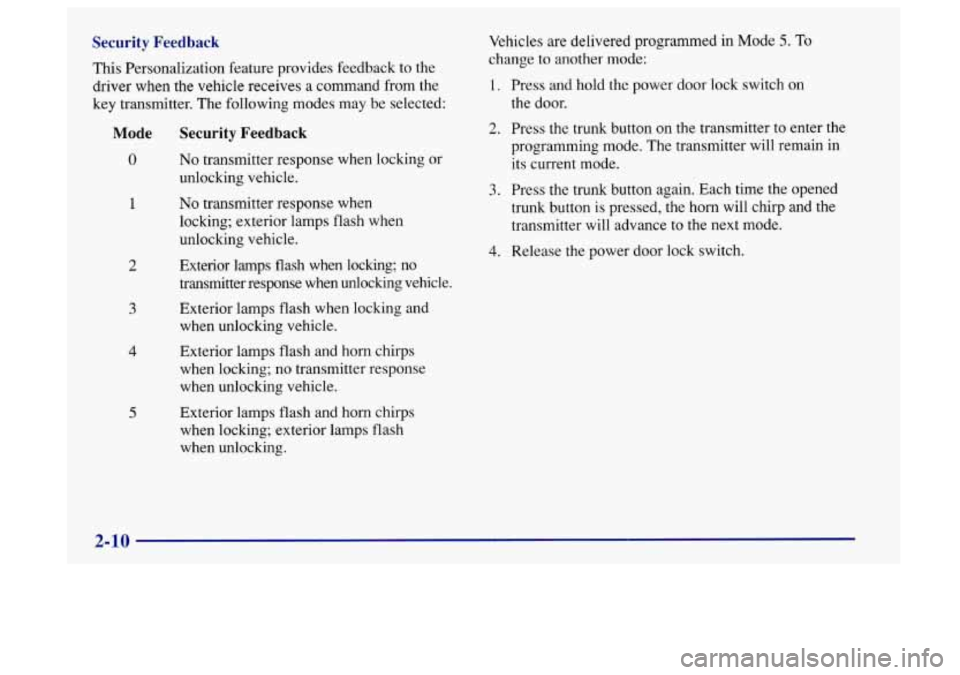
Security Feedback
This Personalization feature provides feedback to the
driver when the vehicle receives a command from the
key transmitter. The following modes may be selected:
Mode
0
1
2
3
4
5
Security Feedback
No transmitter response when locking or
unlocking vehicle.
No transmitter response when
locking; exterior lamps flash when
unlocking vehicle.
Exterior lamps flash when locking; no
transmitter response when unlocking vehicle.
Exterior lamps flash when locking and
when unlocking vehicle.
Exterior lamps flash and horn chirps
when locking; no transmitter response
when unlocking vehicle.
Exterior lamps flash and horn chirps
when locking; exterior lamps flash
when unlocking. Vehicles
are delivered programmed in Mode
5. To
change to another mode:
1.
2.
3.
4.
Press and hold the power door lock switch on
the door.
Press the trunk button on the transmitter to enter the
programming mode. The transmitter will remain in
its current mode.
Press the trunk button again. Each time the opened
trunk button
is pressed, the horn will chirp and the
transmitter will advance to the next mode.
Release the power door lock switch.
2-10
Page 72 of 404
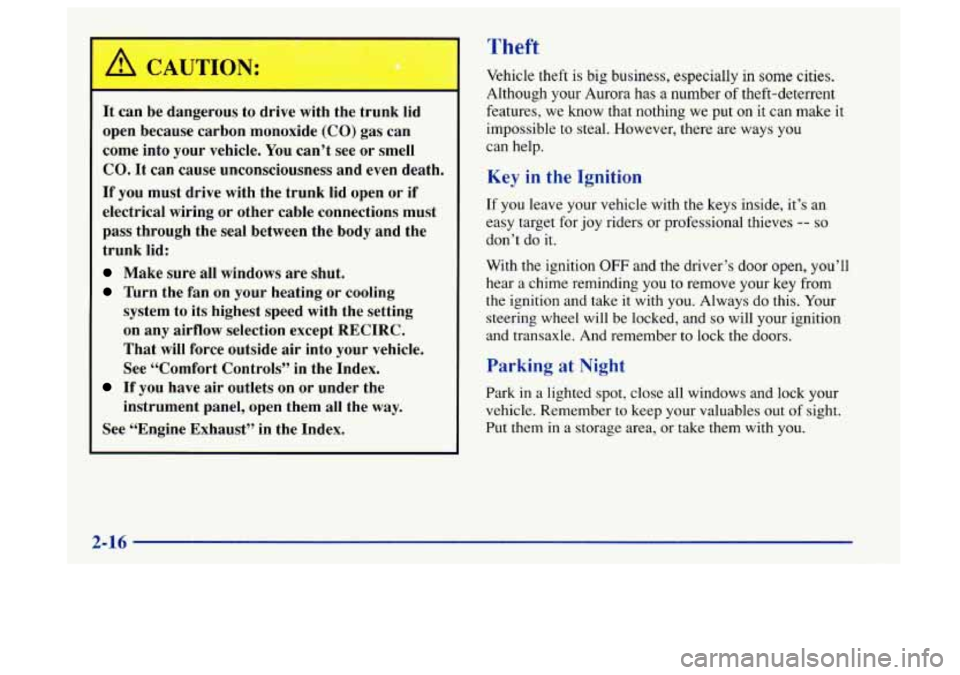
It can be dangerous to drive with the trunk lid
open because carbon monoxide (CO)
gas can
come into your vehicle.
You can’t see or smell
CO. It can cause unconsciousness and even death.
If you must drive with the trunk lid open or if
electrical wiring or other cable connections must
pass through the seal between the body and the
trunk lid:
Make sure all windows are shut.
Turn the fan on your heating or cooling
system to its highest speed with the setting
on any airflow selection except RECIRC.
That will force outside air into your vehicle.
See “Comfort Controls” in the Index.
If you have air outlets on or under the
instrument panel, open them
all the way.
See “Engine Exhaust” in the Index.
Theft
Vehicle theft is big business, especially in some cities.
Although your Aurora has a number of theft-deterrent
features, we know that nothing we put on
it can make it
impossible
to steal. However, there are ways you
can help.
Key in the Ignition
If you leave your vehicle with the keys inside, it’s an
easy target for joy riders or professional thieves
-- so
don’t do it.
With the ignition
OFF and the driver’s door open, you’ll
hear a chime reminding you to remove your key from
the ignition and take it with you. Always do this. Your
steering wheel will be locked, and
so will your ignition
and transaxle. And remember
to lock the doors.
Parking at Night
Park in a lighted spot, close all windows and lock your
vehicle. Remember to keep your valuables out
of sight.
Put them in a storage area, or take them with you.
2-16
Page 100 of 404
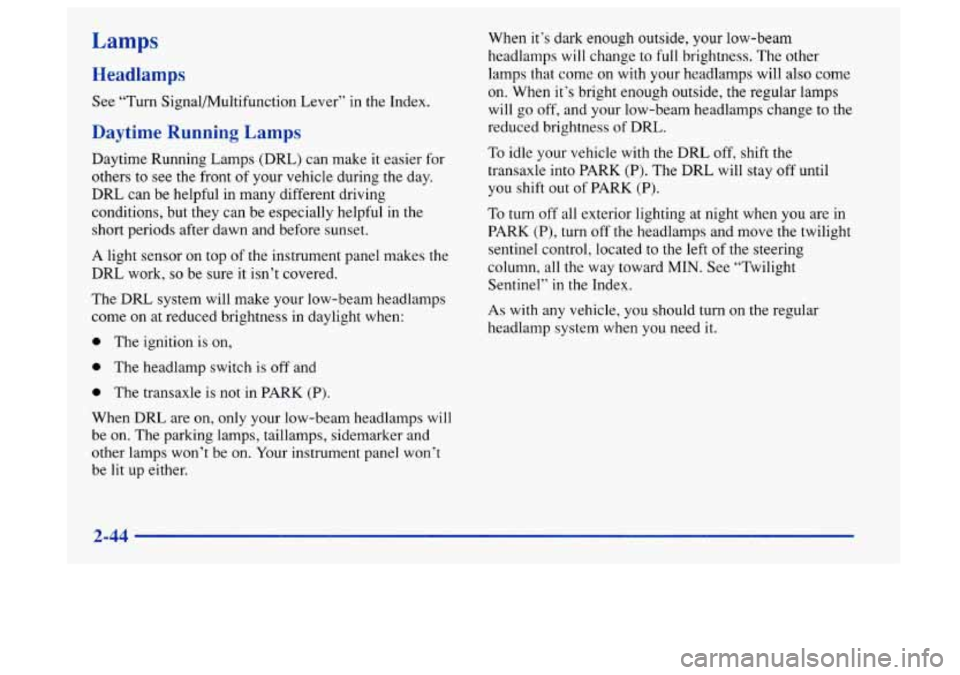
Lamps
Headlamps
See “Turn Signal/Multifunction Lever” in the Index.
Daytime Running Lamps
Daytime Running Lamps (DRL) can make it easier for
others to see the front
of your vehicle during the day.
DRL can be helpful in many different driving
conditions, but they can be especially helpful in the
short periods after dawn and before sunset.
A light sensor on top of the instrument panel makes the
DRL work,
so be sure it isn’t covered.
The DRL system will make your low-beam headlamps
come on at reduced brightness in daylight when:
0 The ignition is on,
0 The headlamp switch is off and
0 The transaxle is not in PARK (P).
When DRL are
on, only your low-beam headlamps will
be on. The parking lamps, taillamps, sidemarker and
other lamps won’t be
on. Your instrument panel won’t
be lit up either. When it’s
dark enough outside, your low-beam
headlamps will change to full brightness. The other
lamps that come on with your headlamps will also come
on. When it’s bright enough outside, the regular lamps
will
go off, and your low-beam headlamps change to the
reduced brightness of DRL.
To idle your vehicle with the DRL off, shift the
transaxle into PARK
(P). The DRL will stay off until
you shift out of PARK
(P).
To turn off all exterior lighting at night when you are in
PARK (P), turn off the headlamps and move the twilight
sentinel control, located to the left
of the steering
column, all
the way toward MIN. See “Twilight
Sentinel” in
the Index.
As with any vehicle, you should turn on the regular
headlamp system when you need
it.
2-44
Page 173 of 404

Understanding Radio Reception
FM Stereo
FM stereo will give you the best sound. But
FM signals
will reach only about
10 to 40 miles ( 16 to 65 km). Tall
buildings or hills can interfere with
FM signals, causing
the sound to come and
go.
AM
The range for most AM stations is greater than for FM,
especially at night. The longer range, however, can
cause stations to interfere with each other. AM can pick
up noise from things like storms and power lines. Try
reducing the treble
to reduce this noise if you ever get it.
Tips About Your Audio System
Hearing damage from loud noise is almost undetectable
until it is too late. Your hearing can adapt to higher
volumes
of sound. Sound that seems normal can be loud
and harmful to your hearing. Take precautions by
adjusting the volume control on your radio to a safe
sound level before your hearing adapts to it. To
help avoid hearing loss or damage:
Adjust the volume control to the lowest setting.
Increase volume slowly until you hear comfortably
and clearly.
NOTICE:
Before you add any sound equipment to your
vehicle
-- like a tape player, CB radio, mobile
telephone or two-way radio
-- be sure you can add
what you want.
If you can, it’s very important to
do it properly. Added sound equipment may
interfere with the operation of your vehicle’s
engine, Delco radio or other systems, and even
damage them. Your vehicle’s systems may interfere
with the operation of sound equipment that has
been added improperly.
So, before adding sound equipment, check with
your retailer and be sure to check Federal rules
covering mobile radio and telephone units.
3-29
Page 181 of 404

The body takes about an hour to rid itself of the alcohol
in one drink.
No amount of coffee or number of cold
showers will speed that up.
“I’ll be careful” isn’t the
right answer. What
if there’s an emergency, a need to
take sudden action, as when a child darts into the street?
A person with even a moderate BAC might not be able
to react quickly enough to avoid the collision.
There’s something else about drinking and driving that
many people don’t know. Medical research shows that
alcohol in a person’s system can make crash injuries
worse, especially injuries to the brain, spinal cord or
heart. This means that when anyone who has been
drinking
-- driver or passenger -- is in a crash, that
person’s chance of being killed or permanently disabled
is higher than
if the person had not been drinking.
A CAUTION:
Drinking and then driving is very dangerous.
Your reflexes, perceptions, attentiveness and
judgment can be affected by even
a small amount
of alcohol. You can have
a serious -- or even
fatal
-- collision if you drive after drinking.
Please don’t drink and drive or ride with
a driver
who has been drinking. Ride home in a cab; or if
you’re with
a group, designate a driver who will
not drink.
Page 185 of 404

Remember: Anti-lock doesn’t change the time you need
to get your foot up to the brake pedal or always decrease
stopping distance. If you get too close to the vehicle in
front
of you, you won’t have time to apply your brakes
if that vehicle suddenly slows or stops. Always leave
enough room up ahead to stop, even though you have
anti-lock brakes.
Using Anti-Lock
Don’t pump the brakes. Just hold the brake pedal down
and let anti-lock work for you. You may hear a motor or
clicking noise during a hard stop, but this is normal.
Traction Control System
Your vehicle has a traction control system that limits
wheel spin. This is especially useful in slippery road
conditions. The system operates only if it senses that one
or both of the front wheels are spinning or beginning to
lose traction. When this happens, the system works the
front brakes and reduces engine power to limit
wheel spin.
TRACTION ACTIVE
This light will come on
when your traction control
system is limiting wheel
spin. See “Traction Control
System Active Light” in
the Index.
You may feel or hear the system working, but this
is normal.
If your vehicle is in cruise control when the traction
control system begins to limit wheel spin, the cruise
control will automatically disengage. When road
conditions allow you to safely use it again, you may
re-engage the cruise control. (See “Cruise Control”
in
the Index.)
4-9
Page 186 of 404
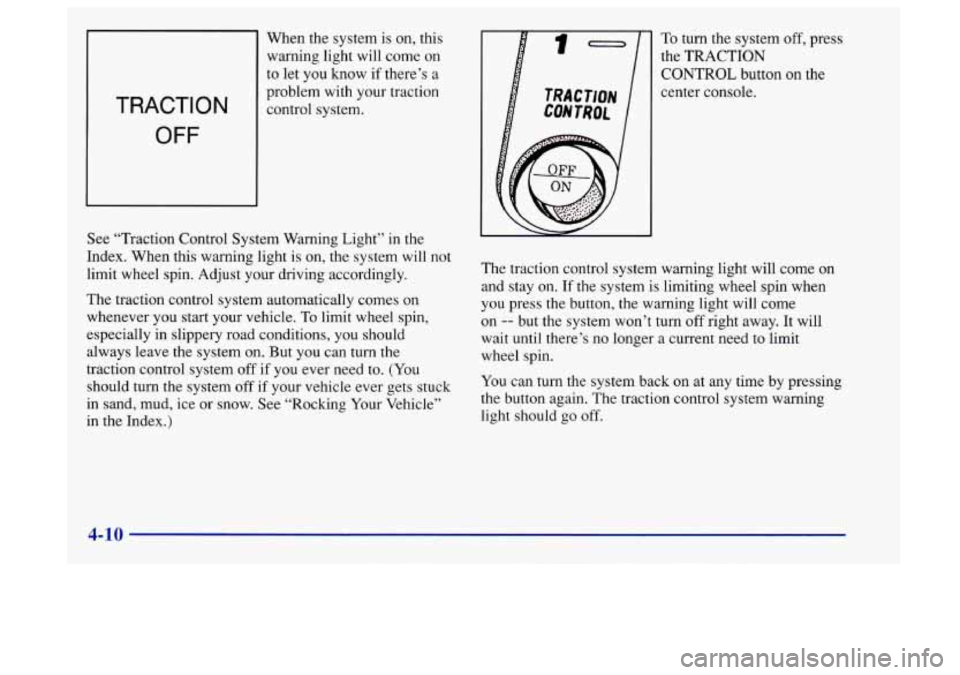
1
When the system is on, this
warning light will come
on
to let you know if there’s a
TRACTION
OFF
I problem with your traction
See “Traction Control System Warning Light” in the
Index. When this warning light is on, the system
will not
limit wheel spin. Adjust your driving accordingly.
The traction control system automatically comes on
whenever you start your vehicle. To limit wheel spin,
especially in slippery road conditions, you should
always leave the system on. But you can
turn the
traction control system off if you ever need to. (You
should turn
the system off if your vehicle ever gets stuck
in sand, mud, ice or snow.
See “Rocking Your Vehicle”
in the Index.) To
turn the system off, press
the TRACTION
CONTROL button
on the
center console.
The traction control system warning light will come
on
and stay on. If the system is limiting wheel spin when
you press the button, the warning light will come
on
-- but the system won’t turn off right away. It will
wait until there’s no longer a current need to limit
wheel spin.
You can turn the system back on at any time by pressing
the button again. The traction control system warning
light should go off.
4-10